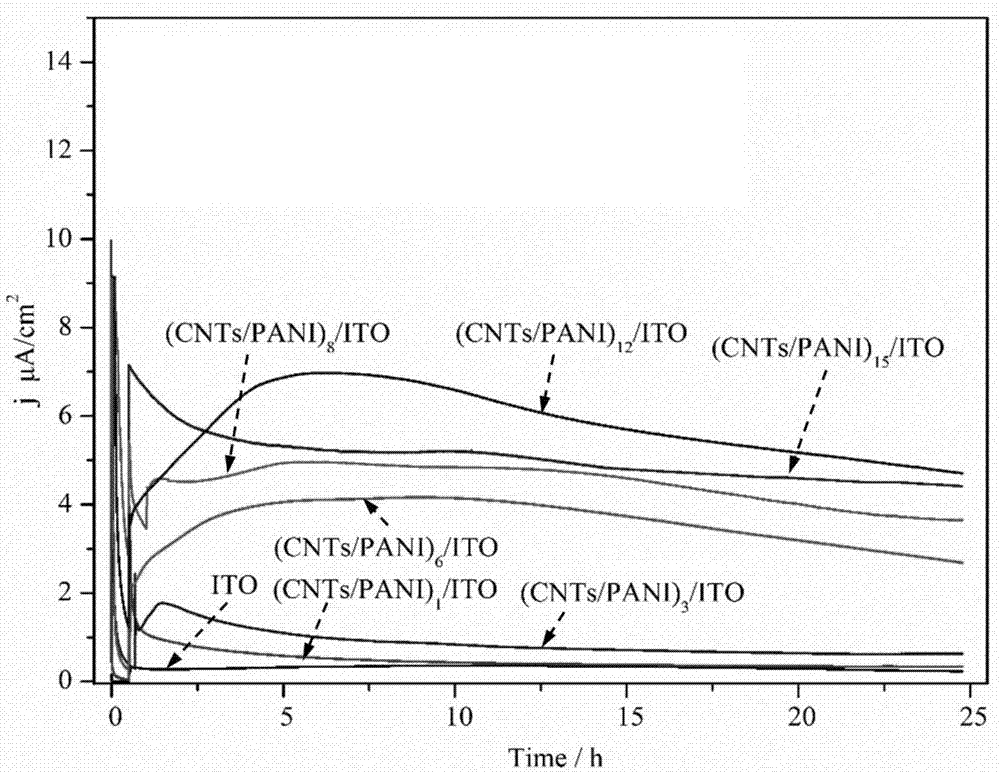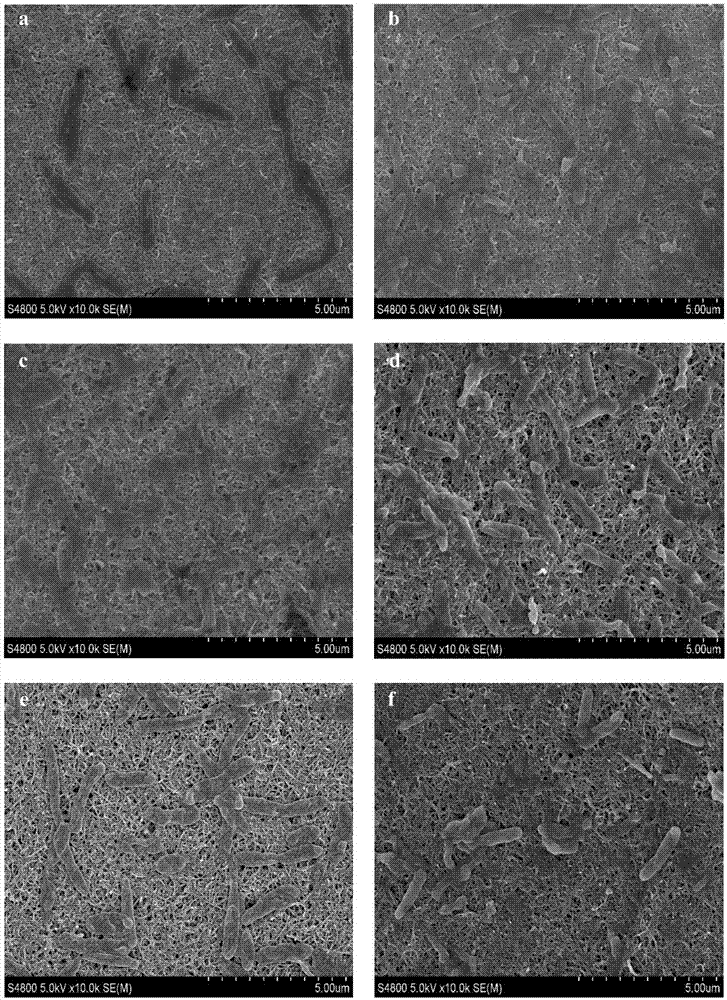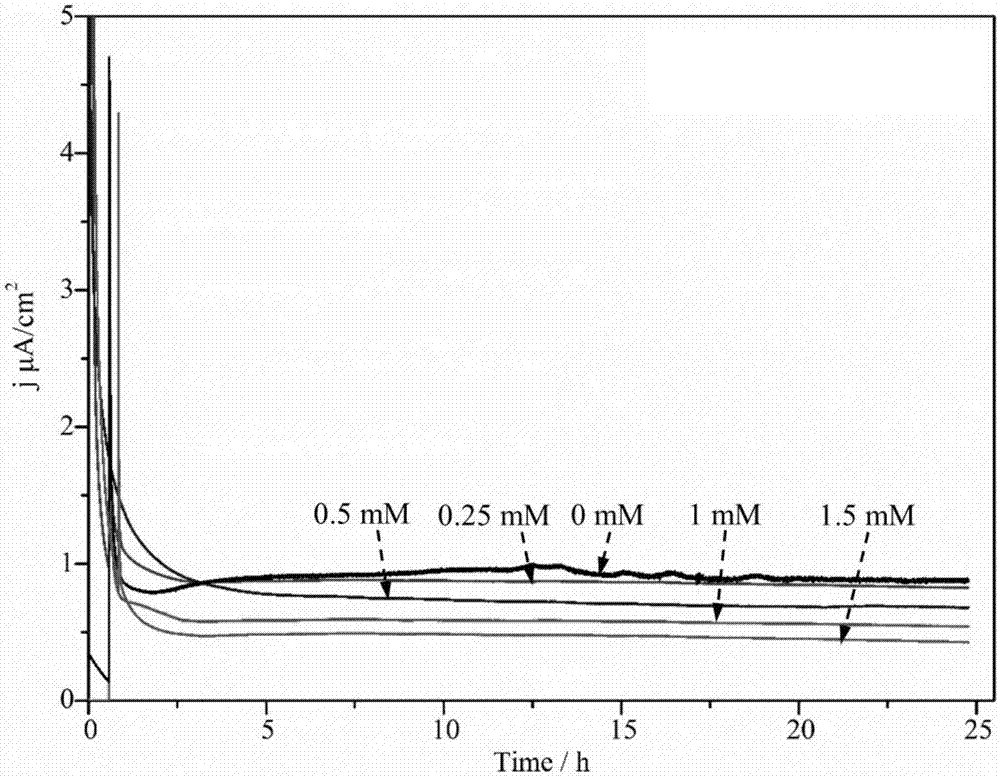Method for using (CNTs/PANI)n-ITO anode-based MFC (Microbial Fuel Cell) biosensors in antibiotic susceptibility tests
A biosensor and drug susceptibility test technology, applied in the field of microbial fuel cell biosensor detection of drugs, can solve the problems of cumbersome operation, long detection time, poor repeatability, etc., to avoid cumbersome operation, improve detection sensitivity, and avoid long detection time Effect
- Summary
- Abstract
- Description
- Claims
- Application Information
AI Technical Summary
Problems solved by technology
Method used
Image
Examples
Embodiment 1
[0031] 1) Immerse the ITO (indium tin oxide) electrode treated with 4% NaOH solution in 25mL of anhydrous toluene solution, add about 1.1g of APTES (3-aminopropyltriethoxysilane), in a nitrogen atmosphere After standing at room temperature for 16 hours, the ITO electrode was taken out, ultrasonically cleaned with toluene, ethanol and deionized water in sequence, and finally dried with nitrogen;
[0032] 2) Use a mixed solution of saturated concentrated nitric acid and concentrated sulfuric acid (v / v, 1:3) to ultrasonically acidify CNTs (carbon nanotubes) for 24 hours, centrifuge, and wash with ultrapure water until the supernatant is neutral; The CNTs obtained by centrifugation were lyophilized and stored, and then prepared into a 1 mg / mL CNTs suspension with ultrapure water;
[0033] 3) Dissolve 100mg of PANI (polyaniline) and 100mg of HCSA (camphorsulfonic acid) in 20mL of chloroform, stir until the solvent is completely evaporated, and then use ultrapure water to ultrasonic...
Embodiment 2
[0038] 1) Immerse the ITO electrode treated with 4% NaOH solution in 25mL of anhydrous toluene solution, add about 1.1g of APTES, place it in a nitrogen atmosphere at room temperature for 16h, take out the ITO electrode, and wash it with toluene, ethanol and deionized Ultrasonic cleaning with water, and finally drying with nitrogen;
[0039] 2) Use a mixed solution of saturated concentrated nitric acid and concentrated sulfuric acid (v / v, 1:3) to ultrasonically acidify CNTs for 24 hours, centrifuge, and wash with ultrapure water until the supernatant is neutral; CNTs obtained by centrifugation Freeze-dried and stored, and then prepared into 1mg / mL CNTs suspension with ultrapure water;
[0040] 3) Dissolve 100 mg of PANI and 100 mg of HCSA in 20 mL of chloroform, stir until the solvent is completely evaporated, and then ultrasonically disperse with ultrapure water to prepare a HCSA-doped PANI solution with a concentration of 1 mg / mL;
[0041] 4) Soak the ITO electrode obtained...
Embodiment 3
[0045] 1) Immerse the ITO electrode treated with 4% NaOH solution in 25mL of anhydrous toluene solution, add about 1.1g of APTES, place it in a nitrogen atmosphere at room temperature for 16h, take out the ITO electrode, and wash it with toluene, ethanol and deionized Ultrasonic cleaning with water, and finally drying with nitrogen;
[0046] 2) Use a mixed solution of saturated concentrated nitric acid and concentrated sulfuric acid (v / v, 1:3) to ultrasonically acidify CNTs for 24 hours, centrifuge, and wash with ultrapure water until the supernatant is neutral; CNTs obtained by centrifugation Freeze-dried and stored, and then prepared into 1mg / mL CNTs suspension with ultrapure water;
[0047] 3) Dissolve 100 mg of PANI and 100 mg of HCSA in 20 mL of chloroform, stir until the solvent is completely evaporated, and then ultrasonically disperse with ultrapure water to prepare a HCSA-doped PANI solution with a concentration of 1 mg / mL;
[0048] 4) Soak the ITO electrode obtained...
PUM
 Login to View More
Login to View More Abstract
Description
Claims
Application Information
 Login to View More
Login to View More - R&D
- Intellectual Property
- Life Sciences
- Materials
- Tech Scout
- Unparalleled Data Quality
- Higher Quality Content
- 60% Fewer Hallucinations
Browse by: Latest US Patents, China's latest patents, Technical Efficacy Thesaurus, Application Domain, Technology Topic, Popular Technical Reports.
© 2025 PatSnap. All rights reserved.Legal|Privacy policy|Modern Slavery Act Transparency Statement|Sitemap|About US| Contact US: help@patsnap.com



